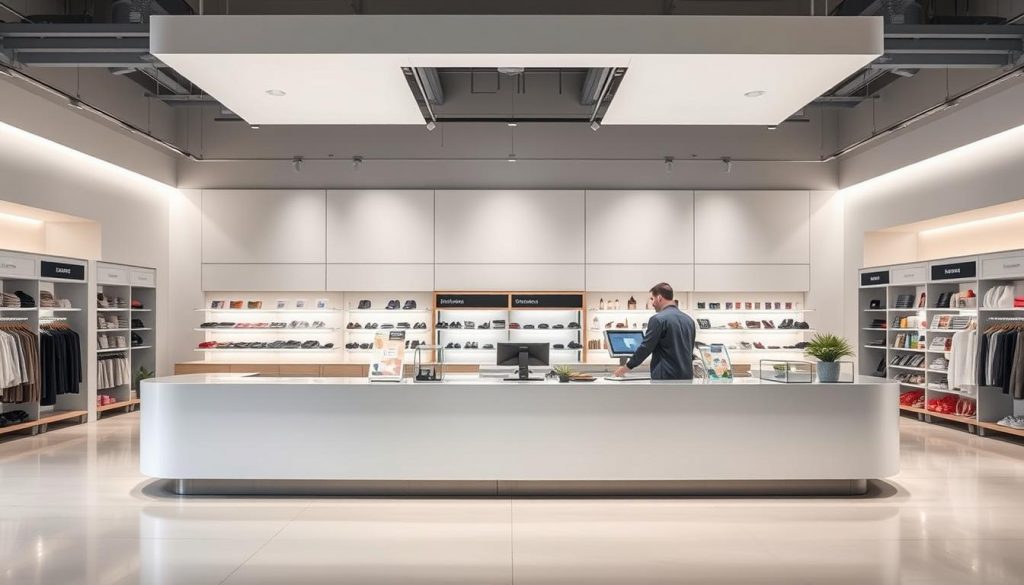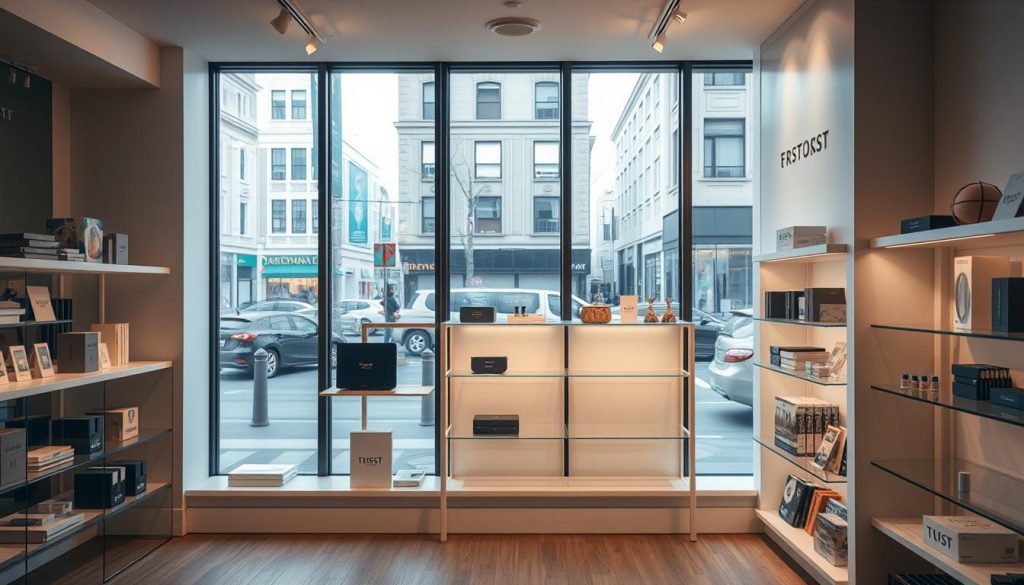Did you know that nearly 70% of online shoppers leave their checkout process incomplete? This startling statistic highlights a major challenge for ecommerce businesses1. Lost sales due to abandoned transactions cost billions annually, making it a critical issue to address2.
Even the best products can suffer when customers face hurdles during the checkout. Unexpected fees, complicated processes, or limited payment options often drive shoppers away1. But the good news? There are proven strategies to turn this around.
In this guide, we’ll explore practical solutions to reduce cart abandonment and boost your sales. From simplifying the checkout flow to offering diverse payment options, we’ll help you create a seamless shopping experience. Let’s dive in and turn those lost opportunities into loyal customers.
Key Takeaways
- Nearly 70% of online shoppers abandon their carts, costing businesses billions1.
- Unexpected fees and complicated checkouts are major reasons for abandonment2.
- Simplifying the checkout process can significantly reduce lost sales.
- Offering diverse payment options improves customer satisfaction.
- Retargeting emails can recover up to 40% of abandoned carts1.
Understanding Cart Abandonment
Online shopping often ends abruptly, leaving businesses with missed opportunities. This phenomenon, where customers leave their transactions incomplete, is a significant challenge for ecommerce stores. It’s not just about lost sales; it’s about understanding why shoppers hesitate to click that final “buy” button3.
Defining the Phenomenon
When a shopper adds items to their virtual basket but doesn’t complete the purchase, it’s called abandonment. This isn’t just window shopping—it’s a signal that something went wrong during the checkout process. Whether it’s unexpected fees or a complicated interface, these hurdles can deter even the most interested customer4.
Key Statistics and Trends
Studies show that the average abandonment rate is nearly 70%, with some industries seeing rates as high as 84%4. High shipping costs, mandatory account creation, and limited payment options are among the top reasons shoppers leave5. Understanding these trends is the first step toward creating a seamless shopping experience that keeps customers engaged.
Analyzing the Causes of Shopping Cart Abandonment
Shoppers often face hurdles that prevent them from completing their purchases. Understanding these challenges is key to improving the checkout page experience and boosting conversion rates6.
Website Interface and Checkout Friction
A cluttered or confusing site design can create unnecessary friction. When users struggle to navigate, they’re more likely to leave without completing their shopping journey7.
Too many steps in the checkout page process also deter customers. Mandatory account creation is another common barrier, with 26% of users abandoning their carts for this reason6.
Unexpected Costs and Shipping Fees
Unexpected fees are a major turnoff for shoppers. High shipping costs, taxes, and other charges account for 48% of incomplete transactions6.
Transparency is crucial. When customers can’t see the total cost upfront, 21% of them abandon their carts7. Offering clear pricing and competitive shipping rates can significantly reduce this issue.
Impact of Cart Abandonment on Ecommerce Revenue
Ecommerce businesses face a silent revenue drain that’s costing them billions annually. Incomplete transactions are more than just missed opportunities—they’re a financial crisis for online retailers. Studies show that the average abandonment rate is nearly 70%, with some industries seeing rates as high as 90%8.
Revenue Losses and Business Implications
Lost sales from incomplete checkouts have a direct impact on a business’s bottom line. For example, products left in abandoned carts total approximately $4 trillion annually8. This staggering figure highlights the scale of the problem.
High abandonment rates also lead to increased customer acquisition costs and negative ROI on marketing spend9. When shoppers leave without completing their purchase, it’s not just a lost sale—it’s a missed chance to build long-term customer relationships.
Immediate effects include lower margins and decreased average order value (AOV)9. Long-term, businesses face challenges in inventory management and customer retention. For instance, 26% of shoppers choose a different retailer after abandoning their carts8.
To address this, businesses must focus on improving the payment process and reducing friction during checkout. Offering diverse payment options and transparent pricing can help recover lost revenue and boost overall sales8.
Enhancing the Checkout Experience
A seamless checkout experience is the cornerstone of converting visitors into loyal customers. When the process is smooth, shoppers are more likely to complete their purchase. Let’s explore how to make this happen.
Simplifying the Checkout Process
Too many steps can frustrate shoppers and lead to incomplete transactions. A streamlined process minimizes unnecessary clicks and keeps the focus on the product. For example, reducing form fields and eliminating mandatory account creation can significantly improve completion rates10.
Top ecommerce platforms like Amazon have mastered this approach. By focusing on simplicity, they’ve set a standard that others can follow. Implementing a one-page checkout or autofill options can make a big difference.

Utilizing Progress Indicators
Shoppers appreciate knowing where they are in the process. Progress indicators provide clarity and reduce uncertainty. They act as a roadmap, guiding customers step-by-step toward completing their purchase11.
These visual cues are especially helpful for complex orders. By showing how many steps remain, you can reassure customers and keep them engaged. This small addition can have a big impact on reducing the cart abandonment rate.
Offering Guest Checkout Options
Mandatory account creation is a common barrier. Many shoppers prefer to check out as guests, especially if they’re in a hurry. Offering this option can reduce friction and encourage more completed transactions10.
Retailers like Target and Walmart have seen success by allowing guest checkouts. This approach respects the customer’s time and simplifies the process. It’s a simple change that can lead to significant improvements.
Providing Transparent Pricing and Shipping Information
Transparency in pricing and shipping details can make or break the online shopping experience. When customers feel informed, they’re more likely to complete their purchase. Hidden fees or unclear delivery times, however, can lead to frustration and lost sales12.
Clear Communication of Fees
Unexpected costs are one of the top reasons shoppers leave their items behind. Studies show that 47% of users abandon their purchase due to extra fees like shipping and taxes12. To build trust, display all costs upfront on the product page and during checkout.
Real-time shipping rate calculators can help. They ensure customers see accurate pricing based on their location. This reduces surprises and improves the overall experience13.
Displaying Estimated Delivery Times
Customers want to know when their items will arrive. Slow delivery accounts for 24% of incomplete transactions12. Providing clear delivery estimates can ease concerns and encourage purchases.
For example, setting expectations like “2-3 business days” or offering expedited options can make a difference. Transparency here not only reduces friction but also enhances customer satisfaction14.
Building Trust and Reducing Purchase Friction
Trust is the foundation of every successful online transaction. When shoppers feel secure, they’re more likely to complete their orders. Enhancing trust elements on your site can ease customer skepticism and reduce hesitation during the checkout process15.

Implementing Trust Signals and Security Badges
Trust signals like security badges reassure users that their payment information is safe. Studies show that 18% of shoppers abandon their purchase if they have concerns about payment security15. Displaying SSL certificates and trusted payment logos can significantly boost confidence.
For example, brands like Amazon and Walmart prominently feature security badges on their checkout pages. This small addition can make a big difference in reducing friction and increasing conversions16.
Creating a Clear Refund and Return Policy
A well-defined return policy is another critical trust element. When users understand the return process, they’re more likely to complete their purchase15. Transparency here builds confidence and reduces hesitation.
Offering flexible return options, such as free returns or extended deadlines, can further enhance trust. For instance, Zappos’ 365-day return policy is a great example of how clarity and flexibility can drive sales16.
| Trust Element | Impact on Conversion Rates |
|---|---|
| Security Badges | Increases trust by 15%15 |
| Clear Return Policy | Boosts conversions by 20%16 |
| Customer Reviews | Improves confidence by 25%15 |
By focusing on these trust-building strategies, you can create a seamless shopping experience that keeps users engaged. For more insights, check out this guide on establishing trust to reduce purchase friction.
Diverse Payment Options for a Seamless Experience
In today’s digital age, offering diverse payment options is no longer a luxury—it’s a necessity for online retailers. With 70% of consumers saying the availability of their preferred payment method is crucial when choosing an online store, meeting these expectations is key to success17.
From digital wallets to interest-free financing, these options cater to the varied preferences of today’s shoppers. By providing flexibility, businesses can reduce friction and create a smoother checkout experience.
Integrating Digital Wallets and Alternative Methods
Digital wallets like Apple Pay, Google Pay, and PayPal are becoming increasingly popular. In 2023, 37% of US shoppers preferred using mobile wallets for their online shopping needs18. These methods offer speed and security, making them a favorite among younger demographics.
For instance, Gen Z and Millennials are twice as likely to use digital wallets over traditional payment methods18. By integrating these options, retailers can appeal to a broader audience and reduce the likelihood of incomplete transactions.
Facilitating Interest-Free Buy Now, Pay Later
Buy now, pay later (BNPL) options are another game-changer. With 33% of shoppers choosing BNPL for its convenience and no interest charges, it’s clear why this method is gaining traction18.
BNPL removes financial barriers, allowing persons to make purchases without immediate strain on their budgets. For example, 31% of users rely on BNPL to manage their finances better18. Offering this option can significantly boost conversion rates and customer satisfaction.
“Flexibility in payment options is no longer optional—it’s a critical factor in winning over today’s shoppers.”
By embracing diverse payment methods, retailers can meet the expectations of a wide range of consumers. Whether it’s through digital wallets or BNPL, these strategies ensure a seamless and inclusive shopping experience.
Optimizing Website Performance and User Interface
A slow website can cost you more than just time—it can drive customers away. Research shows that 40% of users abandon a site that takes more than 3 seconds to load19. This directly impacts your abandonment rate and overall conversion numbers. Improving site speed and ensuring cross-device functionality are essential steps to keep users engaged.
When your site loads quickly, it creates a smoother experience for visitors. Websites that load in 2 seconds or less see a 9% higher conversion rate compared to slower sites19. This highlights the importance of optimizing performance to reduce friction and encourage users to complete their purchases.
Improving Site Speed and Cross-Device Functionality
Site speed is a critical factor in user satisfaction. Slow load times not only frustrate visitors but also increase the likelihood of them leaving without making a purchase. Investing in faster hosting, optimizing images, and minimizing code can significantly improve performance20.
Mobile optimization is equally important. With 54% of e-commerce sales coming from mobile devices, ensuring your site works seamlessly across all platforms is a must19. A responsive design and streamlined navigation can make a big difference in reducing your abandonment rate.
Here are some actionable steps to enhance your site’s performance:
- Use a content delivery network (CDN) to reduce load times.
- Compress images and videos to improve speed.
- Test your site’s performance regularly to identify bottlenecks.
By focusing on these technical improvements, you can create a better user experience and boost your conversion rates. For more insights on e-commerce strategies, explore our detailed guide.
Effective Follow-Up and Retargeting Strategies
Re-engaging customers after they leave your site is a powerful way to recover lost sales. With nearly 70% of online shoppers leaving their transactions incomplete, smart retargeting methods can turn these missed opportunities into conversions21. By implementing timely reminders and personalized messages, we can bring shoppers back to complete their purchases.
Implementing Cart Recovery Emails
Cart recovery emails are one of the most effective tools for re-engaging users. Studies show that these emails have a 46.1% open rate and a 4.64% conversion rate, significantly higher than regular promotional emails21. Sending a follow-up email within three hours of abandonment can yield an open rate of 40% and a click-through rate of 20%22.
To maximize impact, ensure your emails are clear and concise. Include a strong call-to-action (CTA) that directs users back to their payment page. Personalization, such as addressing the customer by name and showcasing the items they left behind, can also increase engagement.
Leveraging Exit-Intent Pop-Ups
Exit-intent pop-ups are another powerful tool for capturing the attention of users about to leave your site. These pop-ups can offer incentives like discounts or free shipping to encourage them to complete their purchase21. For example, a well-timed offer can reduce abandonment rates by up to 10%22.
Design your pop-ups to be visually appealing and easy to close. Use clear messaging and a straightforward form to collect information or apply the offer. This approach ensures a smooth user experience while increasing the likelihood of conversion.
“Retargeting strategies like recovery emails and exit-intent pop-ups can recover up to 50% of incomplete transactions when executed effectively.”
| Strategy | Impact |
|---|---|
| Cart Recovery Emails | 4.64% conversion rate21 |
| Exit-Intent Pop-Ups | Reduces abandonment by 10%22 |
| Personalized Follow-Ups | 23% higher conversion rate21 |
By focusing on these strategies, we can create a seamless follow-up flow that converts lost opportunities into sales. For more insights, explore our guide on smart retargeting techniques.
Cart Abandonment: Data-Driven Insights
Understanding where customers drop off in the conversion funnel is key to boosting sales. By analyzing customer behavior, we can identify critical friction points and take actionable steps to improve the conversion rate23. Tools like Google Analytics provide valuable insights into where and why shoppers leave, helping us address these issues effectively.
Uncovering Weaknesses in the Conversion Funnel
Data reveals that 14% of customers exit their session after an error occurs, while 44% bounce after viewing only one page23. These metrics highlight areas where the funnel leaks. For example, a poorly optimized credit card form can cause significant drop-offs. By monitoring these points, we can make informed decisions to streamline the process.
Real-time analytics can also trigger personalized actions, such as offering discounts when a shopper hesitates at checkout24. This proactive approach reduces friction and encourages users to complete their purchase.
Monitoring Key Metrics
Tracking metrics like conversion rate and checkout flow efficiency is essential. Research shows that 70% of incomplete transactions occur due to unexpected fees or complicated processes24. By focusing on these areas, we can optimize the funnel and improve overall performance.
For instance, Yves Rocher boosted its purchase rate by 11 times by leveraging AI for real-time product recommendations24. This demonstrates the power of data-driven strategies in enhancing the shopping experience.
Interpreting Customer Behavior Data
Understanding customer behavior helps us pinpoint where improvements are needed. For example, 67% of shoppers value relevant product recommendations when deciding whether to complete a purchase24. By analyzing this datum, we can tailor our approach to meet their expectations.
Predictive analytics can also identify customers likely to leave, allowing us to take proactive measures24. This ensures a smoother journey and increases the likelihood of a successful return.
Optimizing the Funnel
Based on hard datum, we can implement changes that address specific issues. For example, reducing the number of steps in the checkout process or offering guest checkout options can significantly improve the conversion rate23.
By focusing on data-driven insights, we can create a seamless experience that keeps customers engaged and drives sales. For more strategies, explore our guide on optimizing the conversion funnel.
Conclusion
Every online shopping journey can be a win-win for both consumers and businesses when done right. By simplifying the checkout process and offering diverse payment options, we can create a seamless experience that keeps visitors engaged25.
Transparency is key. Displaying clear pricing and shipping information upfront reduces hesitation and builds trust. For example, 48% of shoppers leave due to unexpected costs, so clarity is essential25.
We’ve also seen how guest checkout options and trust signals like security badges can significantly improve conversion rates. These small changes make a big difference in the overall customer journey.
Let’s take action today. Implement these strategies to recapture lost revenue and create a shopping experience that delights your customers. Together, we can turn challenges into opportunities for growth.
FAQ
What is shopping cart abandonment?
Why do customers abandon their carts?
How does cart abandonment affect my business?
How can I improve the checkout experience?
Why is transparent pricing important?
What payment options should I offer?
How can I build trust with shoppers?
What role does website performance play?
How can I recover abandoned carts?
How do I analyze cart abandonment data?
Source Links
- Reduce cart abandonment: 9 proven solutions to recover potential sales – https://www.fullstory.com/blog/reduce-cart-abandonment/
- How to Reduce Shopping Cart Abandonment (2025) – Shopify – https://www.shopify.com/enterprise/blog/44272899-how-to-reduce-shopping-cart-abandonment-by-optimizing-the-checkout
- What is shopping cart abandonment? – https://www.optimizely.com/optimization-glossary/shopping-cart-abandonment/
- How to understand, calculate, and reduce shopping cart abandonment – https://thegood.com/insights/shopping-cart-abandonment/
- What is cart abandonment? Here’s how to prevent it | Stripe – https://stripe.com/resources/more/what-is-cart-abandonment
- Understanding shopping cart abandonment – https://yoast.com/shopping-cart-abandonment/
- How To Reduce Cart Abandonment and Close Sales (2024) – Shopify – https://www.shopify.com/blog/shopping-cart-abandonment
- Ecommerce: 23 Insightful Stats on Shopping Cart Abandonment – https://www.hotjar.com/blog/cart-abandonment-stats/
- 5 Unexpected Effects of Shopping Cart Abandonment | Persado – https://www.persado.com/articles/effects-of-shopping-cart-abandonment/
- Abandoned Cart: Common Reasons + Techniques to Reduce Lost Sales – https://www.bigcommerce.com/articles/ecommerce/abandoned-carts/
- How To Reduce Cart Abandonment | Improve Checkout UX – https://www.usertesting.com/blog/how-to-reduce-cart-abandonment
- Shocking Relation Between Shopping Cart Abandonment & Your Shipping Strategies Which Is Costing You $1000s Monthly – Tyche Softwares – https://www.tychesoftwares.com/shopping-cart-abandonment-and-shipping-strategy-relation/
- Shipedge – How to Reduce Cart Abandonment with Strategic Shipping Options? – https://www.shipedge.com/blog/shipping/reduce-cart-abandonment-shipping
- How to Reduce Cart Abandonment – https://commercetools.com/blog/guest-checkout-reducing-cart-abandonment-in-online-shopping
- Reducing cart abandonment 101: 11 tactics to try | Stripe – https://stripe.com/resources/more/how-to-reduce-cart-abandonment
- 13 Ways to Reduce Cart Abandonment – https://www.withremark.com/blog/reduce-cart-abandonment
- Reduce cart abandonment with multiple payment methods in e-commerce — silkpay – https://www.silkpay.us/blog/reduce-cart-abandonment-with-multiple-payment-methods-in-e-commerce
- The Role of Diverse Payment Options – https://www.paypal.com/us/brc/article/diverse-payment-option-impact-on-cart-abandonment
- Reducing Cart Abandonment Using UI/UX – Steele Consulting Inc. – https://www.steeleconsult.com/reducing-cart-abandonment-using-ui-ux/
- How to Reduce Cart Abandonment: 12 Key Strategies – https://www.gorgias.com/blog/reduce-cart-abandonment
- How to Create an Effective Abandoned Cart Strategy | AdRoll – https://www.adroll.com/blog/abandoned-carts-101-everything-you-need-to-know-about-creating-an-effective-abandoned-cart-recovery-strategy
- 7 Abandoned cart recovery strategies to generate sales – https://www.ryder.com/en-us/insights/blogs/e-comm/abandoned-cart-strategies
- Reducing cart abandonment with behavioral data – https://www.fullstory.com/blog/reducing-cart-abandonment-with-behavioral-data/
- How To Reduce Cart Abandonment With AI – https://www.bloomreach.com/en/blog/how-to-reduce-cart-abandonment-with-ai
- Cart Abandonment: Reasons and Strategies to Reduce It – https://www.growave.io/blog/how-to-avoid-abandoned-cart-syndrome




0 Comments